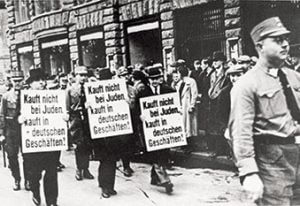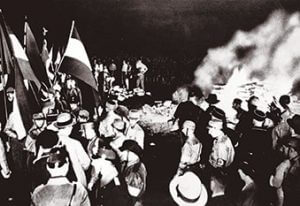
Credit: Yad Vashem
In 1933 German Jews — approximately 500,000 — comprised less than one per cent of the overall population. They were loyal citizens. The Jewish community had been part of German life and culture for 1600 years. More than 100,000 Jews had served in the German army in World War I and a disproportionately high number of them had won military honours. Many Jews harboured the illusion that the important role they played in industry and trade, as well as their contributions to the German economy, would protect them from being completely excluded.
Nazi anti-Jewish policy operated on two main levels; the first relied on legal means to force Jews from society and deprive them of their civil rights and property. The second relied on violence, intimidation and fear. Both had the same aim: to rid Germany of its Jews. From the beginning of Nazi rule, Joseph Goebbels, Hitler’s Minister for Propaganda and National Enlightenment, orchestrated a relentless public campaign of hatred against German Jews. He developed the use of mass media as a calculated instrument for the incitement of racial hatred. A number of major films were produced and promoted by him, glorifying Nazism and attacking Jews. The Eternal Jew, which likened Jews to a mass of rats pouring out of a sewer and over-running a map of Europe, is one example.
The Nazi newspaper Der Stürmer became notorious for its vicious antisemitic articles and cartoons, which came to define the Jew in Nazi propaganda. From 1933 copies were displayed in the street in glass cabinets throughout the country.
Shortly after the Nazis gained power, street assaults against Jews became commonplace throughout Germany, and the perpetrators often went unpunished. On 23 March 1933 a concentration camp was established at Dachau, near Munich. At first Dachau as well as other concentration camps, such as Sachsenhausen, Buchenwald, Flossenbȕrg, Mauthausen and Ravensbrȕck, were used to imprison trade unionists, communists, socialists and any other political opponents deemed to be enemies of the Reich. Later they were also used to incarcerate Jews, Roma, Gypsies and homosexuals.

On 1 April 1933 a general boycott against German Jewish businesses was declared, in which paramilitary SA members stood outside Jewish-owned shops prohibiting customers from entering. About a week later, a law was enacted which ostensibly purged the civil service of all officials of Jewish origin and people considered disloyal to the regime. It was the first racial law that aimed to isolate Jews and expel them from German society. Jews were also dismissed from the judicial system and public hospitals. Books written by Jews and other works deemed offensive to the regime were publicly burned in a ceremonial bonfire.
